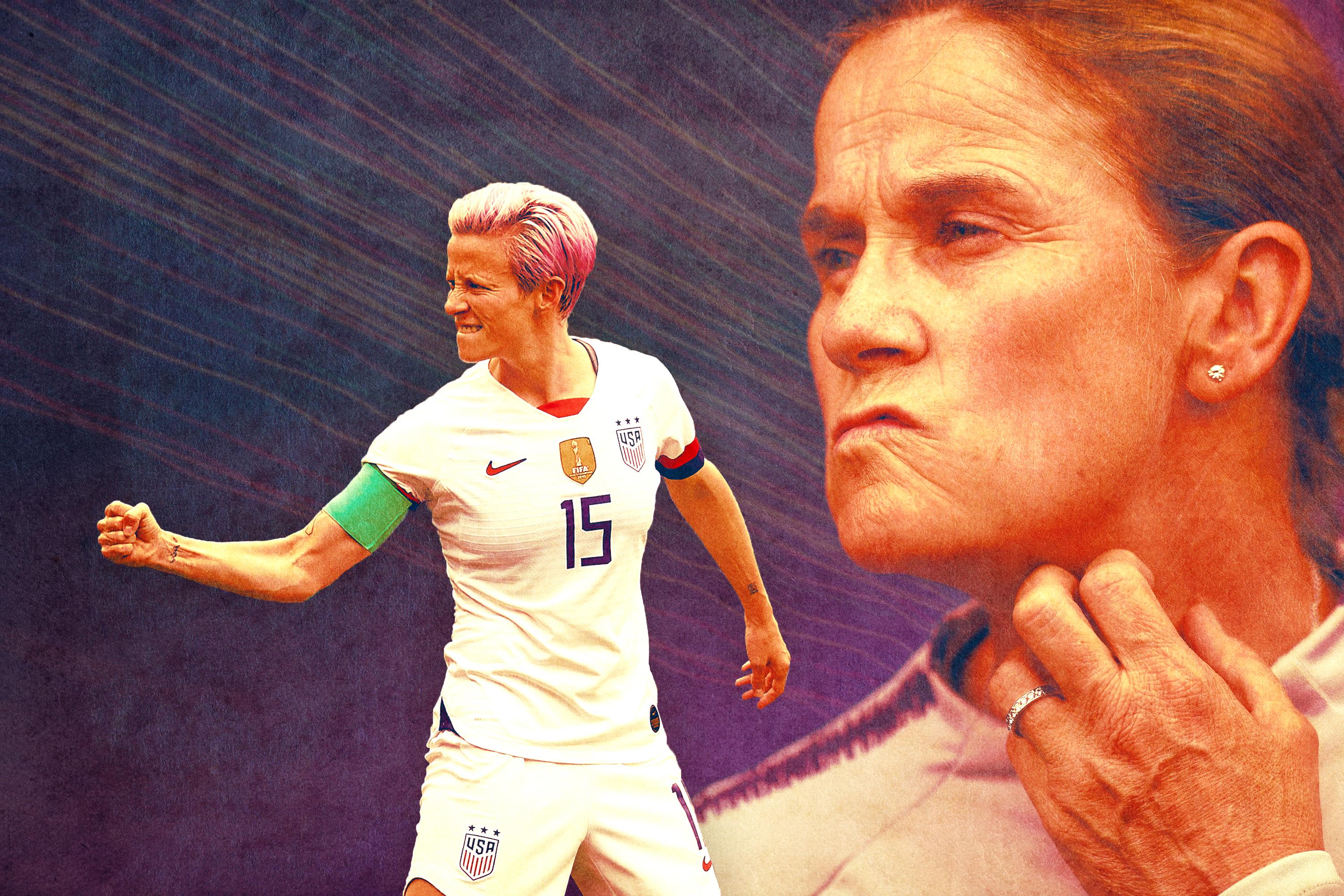
Actually, VAR is good now.
Thanks to two penalty-kick goals from Megan Rapinoe, the second after the controversial video review system confirmed a controversial refereeing decision, the United States survived a nervy round of 16 match Monday, defeating Spain 2-1. Advancement is all that matters in an elimination tournament, so the U.S. did its job. But after a perfect group-stage showing, the nail-biter against Spain raised plenty of concerns about the USWNT’s rest-of-tournament prospects, just in time for a blockbuster quarterfinal against host and cofavorite France.
Those two titans will meet on Friday at 3 p.m. ET in Paris, meaning the U.S. has just a few days to regroup and plan for its greatest test of the tournament. Here are two key questions that will hover over the team until then and beyond.
Is the Back Line Good Enough?
Monday’s match started easily enough, with yet another U.S. goal in the first dozen minutes—an achievement they’ve reached in all four games at this World Cup. Less than five minutes in, Tobin Heath collected a pinpoint Abby Dahlkemper long ball and cut back inside the 18-yard box, only to be tripped by a Spanish defender. Rapinoe followed with a calm penalty strike to the left corner of the net, but the lead would not last long.
Just two minutes after Rapinoe’s goal, relatively untested keeper Alyssa Naeher looked confused about where to move the ball after receiving a pass back. She eventually settled on a short pass to center back Becky Sauerbrunn, who immediately surrendered possession to the Spanish press. Jennifer Hermoso collected the loose ball and floated a shot past Naeher, stuck between staying her line and charging, and thus became the first player to score on this U.S. side since April.
Entering the tournament, the U.S. attacking riches were Rockefellian; their midfield starters were as dynamic as any in the World Cup field. But the defense and goalkeeping were comparatively uncertain, and the easy group stage didn’t provide much stress testing for the back line. Naeher in particular has looked shaky: Against Chile in the second group game, she whiffed while trying to parry a free kick, avoiding a goal allowed only because the targeted striker was offside, and throughout the win against Spain, she produced several nerve-racking moments with her ball control and distribution.
The defense wasn’t wholly holey on Monday. Dahlkemper has played mistake-free soccer all tournament, for instance, and on the left side, converted forward Crystal Dunn recovered from an inconsistent group showing, inspiring more confidence ahead of a matchup against France’s speedy Kadidiatou Diani. Overall, Spain produced just one shot on target and 0.4 expected goals. On another day, the U.S. back line would receive praise for another strong performance; in the tournament, they’ve allowed less than one expected goal through four games combined.
But soccer is a weak-link sport, meaning that a team is typically only as good as its weakest link (as opposed to a sport like basketball, where a team is generally as good as its strongest link), and it’s clear which U.S. position fits that category. France is physical and clinical in attack and more capable than any U.S. opponent thus far of exploiting opportunities to counter when the midfield streams forward. Naeher’s gaffe wasn’t enough to sink the U.S.’s chances against Spain, but France is another kind of threat entirely.
Does Jill Ellis Know How to Maximize Her Roster’s Depth and Talent?
Monday’s issues started before the match began, with the unveiling of the starting lineups. In the group phase, U.S. coach Ellis was content to take advantage of her squad’s magnificent depth and rotate players; just four of the 11 starters from the first game started in the second. But Monday’s match was the first in the knockout stage, where the best lineups should play every game—even the most overmatched opponent, on paper, can surprise in just 90 minutes. Knockout rounds aren’t the time to get cute with roster choices.
Yet Ellis left Lindsey Horan, whom SB Nation ranked as the second-best midfielder in the world before the tournament, on her bench for 88 minutes against Spain. It’s likely that Ellis was afraid that Horan would pick up her second yellow card of the tournament, rendering her ineligible to play against France, but worrying about the lineup in the next game before advancement is assured is awfully risky. Horan didn’t start, and Horan didn’t come on at halftime with the score tied, and Horan didn’t come on for nearly all of the second half despite the U.S. attack looking tired and formless.
The USWNT took just 10 shots, their lowest output in a game in the tournament, and played even worse on offense as the game progressed and Spain’s physical defensive style—18 fouls to the U.S.’s four—took its toll. In the second half, the Americans completed fewer passes in the final third than Spain did, and they didn’t complete a single pass into the penalty area—this after spending so much time there in the group stage that they could have set up a picnic and dined.
Instead, the winning goal stemmed from a fortunate scuffle at the top of the box, where Rose Lavelle’s attempt to connect to the end of a cross resulted in a studs-up tackle and a penalty call. After a lengthy review, the call was confirmed, and Rapinoe went to the same spot with her second penalty as she had with her first.
Neither U.S. goal came from open play, though, nor did many significant chances: The team amassed just 0.8 expected goals outside its penalty tries. The U.S. could have used Horan’s steady hand, and the U.S. could have also used a healthy and active target striker, but Alex Morgan wasn’t able to fit that latter role. She left the final group match against Sweden at halftime and looked clearly hobbled against Spain, whose defensive tactics meant she spent as much time picking herself up after a fall as she did connecting in cohesive buildup play.
Here too, Ellis waited, and waited, and waited to make a change. In general, soccer managers tend to take too long to make substitutions. A study of the Premier League conducted in 2014 concluded that players subbed on during a match score at the highest per-minute rates, players subbed off score at the second-highest per-minute rates, and players who play all 90 minutes score at the lowest per-minute rates. In other words, teams should sub earlier to benefit both players coming on—imagine a fresh Carli Lloyd or Mallory Pugh enjoying a half-hour to run at tired defensive legs—and players coming off, who don’t have to conserve as much energy if they can expend it over 60 minutes instead of 90. As Ryan O’Hanlon summarized in January of this year, “By not using all three subs earlier in a match, managers are taking a hit in two directions: They lose out on the upside of the effect of three high-energy players and they get hit by the deteriorating performances of the players they’re not subbing out sooner.”
Ellis fell into this trap on Monday. Carli Lloyd finally came on for Morgan in the 85th minute for the U.S.’s first substitution of the match. Add in Horan’s nine minutes of play, counting stoppage time, and Christen Press’s whopping one minute, and the USWNT’s allotment of subs combined for just 23 minutes, perhaps fewer than any one individual sub should garner. None of the subs had a chance to affect the run of play while the outcome was in doubt, despite the team’s depth representing its greatest advantage.
The U.S. manager made one winning decision, at least. Before the referee paused to ask VAR for help, the players wanted Morgan to take the second penalty kick, but Ellis commanded the switch to Rapinoe during the delay. The totemic American forward slotted the second penalty home as easily as she had the first, providing the team with the margin to advance, and affording Ellis an opportunity to redeem herself on Friday.
Her team survived its first real test, at least, even if in unconvincing fashion. The good news is that other top contenders like France and England have also struggled at times during the tournament; the bad news is that the U.S.’s path to another World Cup championship grows much more challenging from here. France in a quarterfinal is up Friday, then possibly England in a semifinal, then possibly Germany or the Netherlands in the final. The U.S. boast the best team in the world, but the margins are so slim at the top that every advantage matters. Spain exposed the first cracks in the Americans’ side; now it’s up to Ellis, Naeher, and the rest of the team to work on repairing them before Friday.

